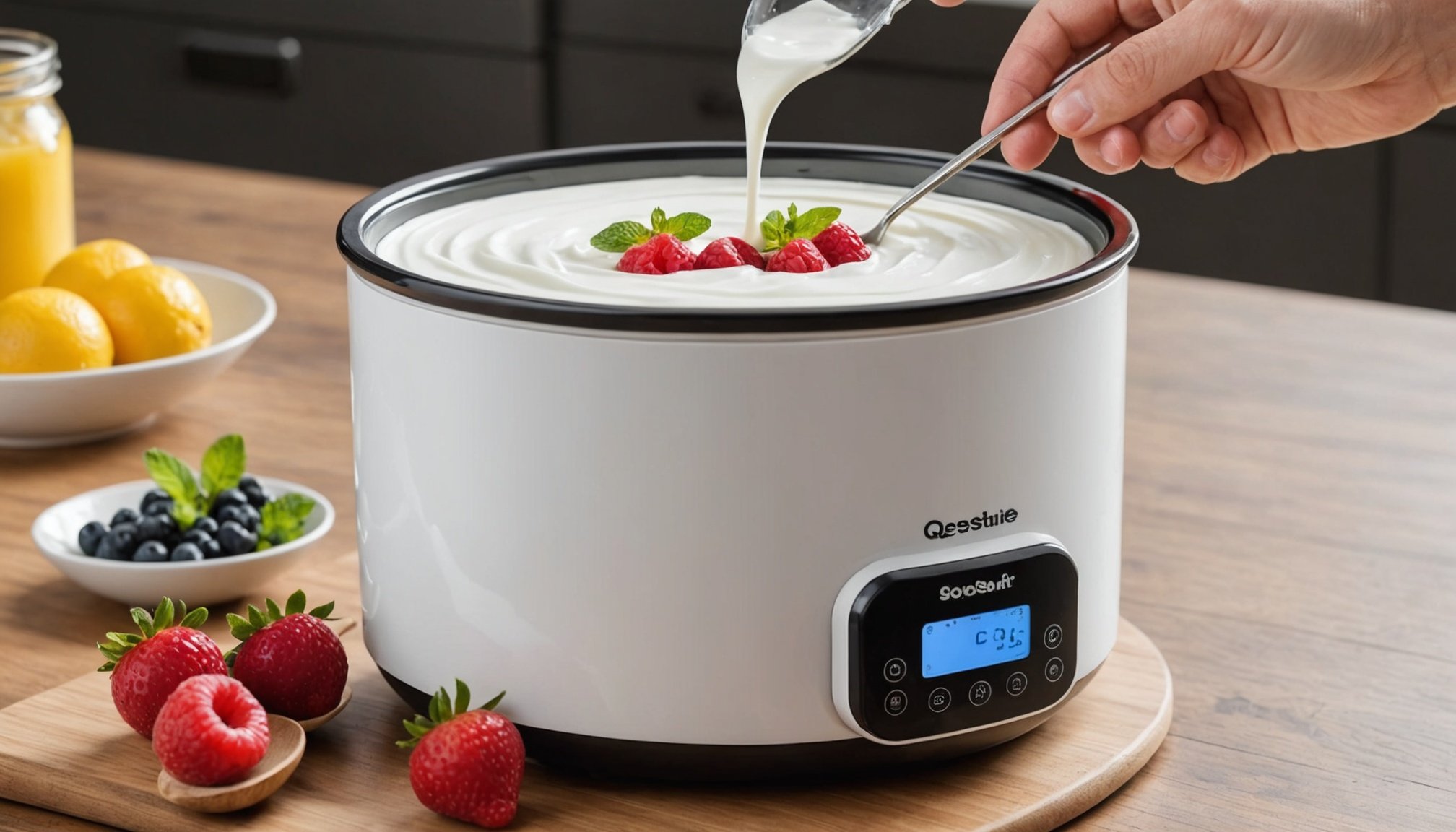Essential Features of Yogurt Makers
Choosing the right yogurt maker might seem daunting, given the plethora of options available. However, understanding the types and key features can greatly ease the process. The market offers various types of yogurt makers, including electric countertop machines, which are simple to use, and more manual options like thermos jars that require careful monitoring.
When considering how to choose a yogurt maker, key features should not be overlooked. Automatic shut-off, for instance, ensures ease and safety during the yogurt-making process, while a digital timer aids in precision. Moreover, models with transparent lids allow you to monitor fermentation without disturbing the process.
Topic to read : Key considerations for selecting the ultimate bread knife for flawless slicing
Temperature control is paramount in making perfect yogurt, as it affects the texture and taste. An ideal yogurt maker maintains consistent temperatures around 110°F, crucial for the live cultures to thrive. Additionally, having control over fermentation time enables customization of yogurt texture and tanginess, ensuring personal taste preferences are met.
Ultimately, the right type of yogurt maker integrates these features to simplify the homemade yogurt process, ensuring delicious results every time.
Tips for Successful Yogurt-Making
With the right approach, achieving delicious homemade yogurt is straightforward. Navigating through recipes is simpler when you understand key yogurt-making tips.
Steps to Prepare Your Yogurt
Sanitation is critical to yogurt-making. Ensure all utensils and jars are clean to avoid bacterial contamination. Start by selecting high-quality milk types; whole milk often gives creamier results, while skimmed milk results in a thinner consistency. For optimal texture, heat the milk to 180°F before cooling it to about 110°F.
Best Ingredients for Making Yogurt
Using the best starter cultures is crucial. Look for live bacteria cultures in either store-bought yogurt or powdered form to kick-start the fermentation process.
Common Mistakes to Avoid
Avoid disruptions during fermentation. Maintain a steady temperature of around 110°F using techniques such as wrapping jars in towels or using an insulated container. For desired consistency, the common yogurt-making errors include inconsistent temperature management and insufficient fermentation time. Adjust these factors as needed. A longer fermentation time can enhance yogurt tanginess, while precise temperature control supports consistent results.
By refining each step, the process becomes a fulfilling kitchen experience that results in delicious and nutritious yogurt.
Benefits of Homemade Yogurt
Embarking on the journey of homemade yogurt not only brings culinary adventure but offers numerous benefits over store-bought options. One significant advantage is the enhanced nutrition. Homemade yogurt contains a higher count of probiotics, the live bacteria essential for gut health, compared to most commercial variants.
In addition to nutritional benefits, homemade yogurt is notably cost-effective. Producing yogurt at home significantly cuts down on the price per serving, especially for those who consume it regularly. By investing in a yogurt maker and choosing quality ingredients, the costs can be considerably lower over time.
Making yogurt at home gives you full control over ingredients and flavours. Whether you wish to indulge in a rich, creamy texture using whole milk or prefer a lighter version with skimmed milk, the choice is yours. Add natural sweeteners like honey or explore flavours with fruits and spices, allowing for delightful personalisation beyond typical offerings from stores.
Crafting your own yogurt not only enriches daily meals with unique flavours but also brings the satisfaction of making healthier, economically sensible choices tailored to individual tastes.
Troubleshooting Common Yogurt-Making Issues
Preparing yogurt can be highly rewarding, yet issues like yogurt consistency problems or fermentation problems can arise. Knowing how to troubleshoot these challenges ensures smooth outcomes.
Signs of Improperly Fermented Yogurt
Improperly fermented yogurt often shows with a thin or watery texture. Missing the desired tanginess is another clear indicator. Proper fermentation relies on maintaining consistent temperatures, typically around 110°F, throughout the process.
Solutions to Consistency Problems
Addressing yogurt consistency issues means correcting temperature fluctuations. Ensure your yogurt maker maintains a stable environment, preventing external impacts like drafts. If the yogurt is too runny, increasing the fermentation time might help, allowing the bacteria more time to work.
Adjusting Fermentation Time and Temperature
To fine-tune your results, consider slightly longer fermentation for more tangy flavors. Check the temperature settings of your maker; a deviation from the ideal 110°F can disrupt bacterial activity. Experimenting with different durations and conditions can lead to improved yogurt quality, aligning with personal taste preferences. With these adjustments, common yogurt-making issues become manageable, creating more fulfilling and successful yogurt batches.
Popular Yogurt Recipes
Embarking on a journey to create your own flavoured yogurt at home can be an enjoyable culinary adventure. Flavoured yogurt offers a myriad of options to suit any palate, allowing for both nutritious and appetising creations.
Basic Yogurt Recipe for Beginners
For those starting, a simple yogurt recipe requires just milk and starter cultures. Begin by heating milk to 180°F, then cool it to 110°F before combining with the cultures. Maintain the mixture at 110°F for several hours.
Creative Ideas for Flavours
Transforming plain yogurt into various flavoured versions involves a touch of creativity. Incorporate fresh fruit like berries, which complement the tang of yogurt beautifully. Sweeten yogurt with honey for a natural sweetness or spice it up with cinnamon or vanilla extract. These simple additions can turn plain yogurt into a unique, tasty treat.
How to Incorporate Yogurt into Meals and Snacks
Incorporating yogurt into meals is versatile. As a healthy snack, add granola or nuts for a satisfying crunch. For savoury dishes, use yogurt as a base for dressings or marinades. This integration offers both nutritional benefits and delightful variety.
Comparing Different Yogurt Maker Models
Exploring the vast array of yogurt maker models available can be daunting. However, understanding the nuances of yogurt maker reviews helps refine choices and identify the best options tailored to your needs.
Several top brands, such as Cuisinart, Euro Cuisine, and Instant Pot, offer distinctive features. Common features include automatic shut-off and digital timers, easing the yogurt-making process. High-end models might provide additional perks like precise temperature control.
Price plays a crucial role in selecting the best yogurt makers. While basic models are budget-friendly, typically under £30, more advanced machines with multiple settings can range above £100. Evaluating your needs against these features assists in balancing cost-effectiveness and functionality.
User-reviewed recommendations often highlight the ease of use, durability, and capacity as key factors. Positive reviews frequently point to models with transparent lids for monitoring without disturbance, illustrating their practicality and efficiency.
When conducting a model comparison, consider seeking feedback from various user reviews about reliability and performance. Alignment with personal needs and preferences ensures the chosen yogurt maker will provide the best value, yielding consistently satisfying homemade yogurts.











